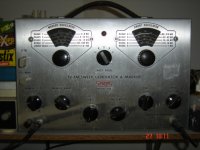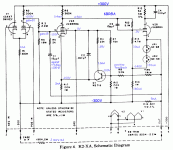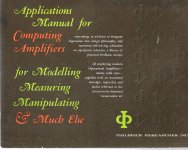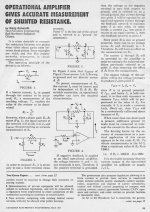"destroyed completely, because the chief of the cathedra didn't know what the thing was."
Sad, sad... Probably a priceless piece of computing history for some museum to have. And likely the first product of Heathkit. The H-1, doubly priceless.
I similarly had a Kay Precision VT chopper stabilized Op. Amp. once, from an IBM surplus outlet. I stupidly threw the thing out after SS Op Amps came along. Might be able to find a schematic online maybe.
It might be interesting to put together a decent VT Op Amp or two. With the 6JH8 beam deflection tube cheaply available, one can do accurate multiplication now. And combined with the Op. Amp. it could do division too. There was a tube that did log conversion also. Would be nice to have some demo modules set up.
That Analog and Hybrid Computer book mentioned above is well worth reading through, a quite in depth treatment. Many fascinating design details and unusual special function generators. There were tubes with contoured beam masks. Analog memory functions.... Special math functions. Really clever stuff.
Sad, sad... Probably a priceless piece of computing history for some museum to have. And likely the first product of Heathkit. The H-1, doubly priceless.
I similarly had a Kay Precision VT chopper stabilized Op. Amp. once, from an IBM surplus outlet. I stupidly threw the thing out after SS Op Amps came along. Might be able to find a schematic online maybe.
It might be interesting to put together a decent VT Op Amp or two. With the 6JH8 beam deflection tube cheaply available, one can do accurate multiplication now. And combined with the Op. Amp. it could do division too. There was a tube that did log conversion also. Would be nice to have some demo modules set up.
That Analog and Hybrid Computer book mentioned above is well worth reading through, a quite in depth treatment. Many fascinating design details and unusual special function generators. There were tubes with contoured beam masks. Analog memory functions.... Special math functions. Really clever stuff.
Surely. I like the "ball game" made in one of the pdf attached below.
People that doesn't know any about old electronic equipment are very dangerous. They simply destroy what the believe to be useful. There are lots of such people in my country, unfortunately.
I saved an old EICO 368 minutes before it goes to trash, by the same reason.
People that doesn't know any about old electronic equipment are very dangerous. They simply destroy what the believe to be useful. There are lots of such people in my country, unfortunately.
I saved an old EICO 368 minutes before it goes to trash, by the same reason.
Attachments
Interesting apparatus. Call my attention the lighter, did you want to put it on fire?
Not my pictures, I found them in the Net. The lighter is for size comparison.
By the way, the apparatus is extremely useful as is. It helps to learn to feel thingies with feedbacks, from amplifiers to human bodies.
> Do anybody experimented or work around Operational Amplifiers made only with vacuum tubes/valves (No ss at all)?
Yes. We "stupidly threw the thing{s} out after SS Op Amps came along." Except I still don't feel stupid (about that). Tube opamps suck. Big, hot, expensive, hissy, and drifty.
The "problem" is that the "operational amplifier" concept is universal and has response to DC. This is needed to hold values in long-time computations and to hold a final result so it can be read on a meter. Tubes have huge DC offsets. Fixing this leads to significant complication and compromise. But in "audio" (including audio oscillators) we do NOT need DC response. True, it may avoid coupling caps. But caps are the lesser evil.
Look at H-P 200AB Wien Bridge oscillator. The Bridge 'begs' for an opamp. H-P got fine performance with much simpler amplifier. R-C coupled twice, and the second R-C needs an electrolytic which fails every 40 years. But an "opamp" implementation would be much messier.
> a novel sine wave RC oscillator that uses no classical frequency selective networks
PLEASE review the literature. Many many ideas never became well known. Don't re-invent wheels.
One obscure trick is a Wien bridge where you only vary one R. It does need an additional opamp to force a virtual ground, so favors cheap-as-chips opamps not tubes. (And FWIW the oldest article I have yet found is early SS days.) It does need a wide-range AGC, and the pot-law is square-root. So not an all-purpose WB oscillator. But very suited to today's parts-market (cheap chips and ill-matched dual pots) for casual bench use.
__________________________
Osvaldo > neon lamps in the signal path. Aren't they noisier?
rayma> They're not in the signal path, they're over-voltage protection clamps.
The K2-W? They ARE the signal path. V2a plate is near +150V. V2b grid must be near-Zero for zero V out. The two neons drop around 150V to allow this to happen, un-offsetting the grid-plate offset of a plate-output tube stage. Yes, this directly feeds neon-hash to V2b. If level is high, it may not matter. (In typical K2-W use, it matters very little, because computations are typically integrations over Time, so the hash averages-out.) There is a 7uuF cap but that does not bypass 680K until above the audio band. It could be bigger, though a physically large cap adds C at a 100+K node which will shave bandwidth. Which is only 100KHz already. Gain <10 at the top of the audio band.
The K2-W was popular, but not high performance. Bell M9 has heaps more gain, though seems to be inverting-only, and that drawing may have errors. (Confusingly, "M-9" also seems to be the name for the Gun Director that Julie's K2-W prototype was for. Much of the early development was War Secret and never well documented.)
Yes. We "stupidly threw the thing{s} out after SS Op Amps came along." Except I still don't feel stupid (about that). Tube opamps suck. Big, hot, expensive, hissy, and drifty.
The "problem" is that the "operational amplifier" concept is universal and has response to DC. This is needed to hold values in long-time computations and to hold a final result so it can be read on a meter. Tubes have huge DC offsets. Fixing this leads to significant complication and compromise. But in "audio" (including audio oscillators) we do NOT need DC response. True, it may avoid coupling caps. But caps are the lesser evil.
Look at H-P 200AB Wien Bridge oscillator. The Bridge 'begs' for an opamp. H-P got fine performance with much simpler amplifier. R-C coupled twice, and the second R-C needs an electrolytic which fails every 40 years. But an "opamp" implementation would be much messier.
> a novel sine wave RC oscillator that uses no classical frequency selective networks
PLEASE review the literature. Many many ideas never became well known. Don't re-invent wheels.
One obscure trick is a Wien bridge where you only vary one R. It does need an additional opamp to force a virtual ground, so favors cheap-as-chips opamps not tubes. (And FWIW the oldest article I have yet found is early SS days.) It does need a wide-range AGC, and the pot-law is square-root. So not an all-purpose WB oscillator. But very suited to today's parts-market (cheap chips and ill-matched dual pots) for casual bench use.
__________________________
Osvaldo > neon lamps in the signal path. Aren't they noisier?
rayma> They're not in the signal path, they're over-voltage protection clamps.
The K2-W? They ARE the signal path. V2a plate is near +150V. V2b grid must be near-Zero for zero V out. The two neons drop around 150V to allow this to happen, un-offsetting the grid-plate offset of a plate-output tube stage. Yes, this directly feeds neon-hash to V2b. If level is high, it may not matter. (In typical K2-W use, it matters very little, because computations are typically integrations over Time, so the hash averages-out.) There is a 7uuF cap but that does not bypass 680K until above the audio band. It could be bigger, though a physically large cap adds C at a 100+K node which will shave bandwidth. Which is only 100KHz already. Gain <10 at the top of the audio band.
The K2-W was popular, but not high performance. Bell M9 has heaps more gain, though seems to be inverting-only, and that drawing may have errors. (Confusingly, "M-9" also seems to be the name for the Gun Director that Julie's K2-W prototype was for. Much of the early development was War Secret and never well documented.)
> over-voltage protection clamps.
Argh! Philbrick made too darn many variations!
Just found K2-XA, which uses the neons not in the signal path but in a bootstrap for the signal path. Slightly "better" in some ways. Does steal precious output current.
http://www.tayloredge.com/museum/museum/opamp.pdf page 6
Note that despite moving to a new tube for pentode 2nd stage and adding a (gasp!) transistor, gain and bandwidth are only about double the K2-W.
Blue text my mark-up.
Recall that these opamps had a couple Volts input offset error (note V1 plates hundreds of Volts apart). They were not "DC accurate" until you nulled that. Then they might hold 8mV/day, as long as HV and 6V are tightly regulated. Can be much worse.
Argh! Philbrick made too darn many variations!
Just found K2-XA, which uses the neons not in the signal path but in a bootstrap for the signal path. Slightly "better" in some ways. Does steal precious output current.
http://www.tayloredge.com/museum/museum/opamp.pdf page 6
Note that despite moving to a new tube for pentode 2nd stage and adding a (gasp!) transistor, gain and bandwidth are only about double the K2-W.
Blue text my mark-up.
Recall that these opamps had a couple Volts input offset error (note V1 plates hundreds of Volts apart). They were not "DC accurate" until you nulled that. Then they might hold 8mV/day, as long as HV and 6V are tightly regulated. Can be much worse.
Attachments
Last edited:
Transistor works as a servo, a Zobel in a nested feedback loop is there for stability on a low closed loop gain.
Edit: sorry, I was wrong. Transistor with the pentode forms kind of a a diff pair, and indeed there is a positive feedback through that transistor.
Edit: sorry, I was wrong. Transistor with the pentode forms kind of a a diff pair, and indeed there is a positive feedback through that transistor.
Last edited:
Yes. I remember Potter and Brumfield choppers in octal bases used in this application. Mid 60's.
In addition, the single pole changeover contact arrangement was mercury wetted (NO bounce!) and a bonus was that the NO and NC contacts were briefly (about 300uS) shorted by the Hg film during operation allowing the production of super clean fast power pulses.
We (Fairchild) used these early on for semiconductor testing, 300uS power 1% duty cycle, still specified in today's datasheets.
NALOPKT!
In addition, the single pole changeover contact arrangement was mercury wetted (NO bounce!) and a bonus was that the NO and NC contacts were briefly (about 300uS) shorted by the Hg film during operation allowing the production of super clean fast power pulses.
We (Fairchild) used these early on for semiconductor testing, 300uS power 1% duty cycle, still specified in today's datasheets.
NALOPKT!
Last edited:
There still are chopper stabilized Op Amps (ICs) around, but not using mechanical choppers now:
Chopper-Stabilized Op Amps | Analog content from Electronic Design
http://pdfserv.maximintegrated.com/en/an/AN4437.pdf
http://cds.linear.com/docs/en/datasheet/1100fc.pdf
There is/was even an add on chopper chip for use with any Op Amp.
Operational amplifier - Knowino
Chopper-Stabilized Op Amps | Analog content from Electronic Design
http://pdfserv.maximintegrated.com/en/an/AN4437.pdf
http://cds.linear.com/docs/en/datasheet/1100fc.pdf
There is/was even an add on chopper chip for use with any Op Amp.
Operational amplifier - Knowino
>PLEASE review the literature. Many many ideas never became well known. Don't re-invent wheels.
Why not? In last case I spent some time uselessly, but it is my time. An finally, perhaps a squared wheel can work pretty fine, no? (I remember a The Pink Panther where the character thought about the consequences of inventing the wheel, and he and his companion quickly destroyed it).
the network as is exists, but I could't find none application to an audio oscillator, so, yes, they didn't invent anything.
One obscure trick is a Wien bridge where you only vary one R. It does need an additional opamp to force a virtual ground, so favors cheap-as-chips opamps not tubes. (And FWIW the oldest article I have yet found is early SS days.) It does need a wide-range AGC, and the pot-law is square-root. So not an all-purpose WB oscillator. But very suited to today's parts-market (cheap chips and ill-matched dual pots) for casual bench use.
Surely it increases distortion.
Osvaldo > neon lamps in the signal path. Aren't they noisier?
rayma> They're not in the signal path, they're over-voltage protection clamps.
Yes, they are between plate of the amplifier and the following grid, to step down the voltages with smaller amplifying loss. But there is a better schema for doing it without loss.
Transistor works as a servo, a Zobel in a nested feedback loop is there for stability on a low closed loop gain.
Edit: sorry, I was wrong. Transistor with the pentode forms kind of a a diff pair, and indeed there is a positive feedback through that transistor.
They would have KILLED for a 741 or even a 709 ... which actually appeared a few years later.
I want NO SS in this project. Better or worse, no sand at all except in the tube bulbs.
One obscure trick is a Wien bridge where you only vary one R. It does need an additional opamp to force a virtual ground, so favors cheap-as-chips opamps not tubes. (And FWIW the oldest article I have yet found is early SS days.) It does need a wide-range AGC, and the pot-law is square-root. So not an all-purpose WB oscillator. But very suited to today's parts-market (cheap chips and ill-matched dual pots) for casual bench use.
This has to be the funniest coincidence in years. You mean Paul Brokaw's article? It is sitting on my desk now as I am sorting out all the stuff of ages that I have collected.
Reading thru this old thread this AM, I realized I still have a copy of one of the 1964 Philbrick Op Amp cookbooks in my pile. Very useful in those days, about 100 pages of actual circuits & applications.
Early in the thread someone mentioned the neon lamps as noisy, there were low noise versions available at the time. They are used as a DC level shifter with minimal signal loss in the K2W & similar circuits. I used a few in DC amplifiers, if they are inside the FB loop, any noise is minimized. Otherwise it was a simple resistive network between stages. But then some gain was lost, depends on the magnitude of the negative supply voltage available.
These days a negative supply is not a problem at all as it was before silicon rectifiers.
Replacing the 2nd 12AX7 in the K2W circuit with a dissimilar triode such as the 6EA7 could come close to drive head phones. Better still the last triode a 6080/6AS7. My thoughts, anyway.
Early in the thread someone mentioned the neon lamps as noisy, there were low noise versions available at the time. They are used as a DC level shifter with minimal signal loss in the K2W & similar circuits. I used a few in DC amplifiers, if they are inside the FB loop, any noise is minimized. Otherwise it was a simple resistive network between stages. But then some gain was lost, depends on the magnitude of the negative supply voltage available.
These days a negative supply is not a problem at all as it was before silicon rectifiers.
Replacing the 2nd 12AX7 in the K2W circuit with a dissimilar triode such as the 6EA7 could come close to drive head phones. Better still the last triode a 6080/6AS7. My thoughts, anyway.
Attachments
The book is now free to dowload as pdf file at Analog devices web site. Applications Manual for Computing Amplifiers for Modeling, Measuring, Manipulating, and Much Else, 1966 | Education | Analog Devices
The Philbrick solid state operational amplifiers quick reference with price list at the end is interesting. The cheapest op amp was $49, that's about $400 today money. Audio was not a target application, I guess. Was it only deployed on flight simulators, aerospace/military applications and research?
The Philbrick solid state operational amplifiers quick reference with price list at the end is interesting. The cheapest op amp was $49, that's about $400 today money. Audio was not a target application, I guess. Was it only deployed on flight simulators, aerospace/military applications and research?
I see no purpose or justification to build anything Audio related with Tube Op Amps.
Horribly expensive, only NASA, Nike missiles and similar could afford them, specs were very poor, stability must have been a problem.
And lots of concessions and compromises were made to optimizd them for DC operation, which helps nothing in Audio.
We use them in Audio only because they were hugely improved, became SS and are dirt cheap. Otherwise ....
Nike Hercules Missile Q5 High Altitude Intercept - YouTube Proper use of Tube Op Amps (and even those first became SS and then Digital)
Nike Hercules Missile Q5 High Altitude Intercept - YouTube
Horribly expensive, only NASA, Nike missiles and similar could afford them, specs were very poor, stability must have been a problem.
And lots of concessions and compromises were made to optimizd them for DC operation, which helps nothing in Audio.
We use them in Audio only because they were hugely improved, became SS and are dirt cheap. Otherwise ....
Nike Hercules Missile Q5 High Altitude Intercept - YouTube Proper use of Tube Op Amps (and even those first became SS and then Digital)
Nike Hercules Missile Q5 High Altitude Intercept - YouTube
- Status
- This old topic is closed. If you want to reopen this topic, contact a moderator using the "Report Post" button.
- Home
- Amplifiers
- Tubes / Valves
- Tube Operational Amplifier



